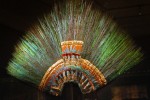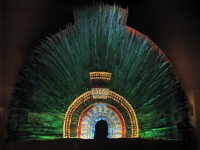 Moctezuma’s headdress is a large and elaborate 16th century crown which according to legend once belonged to Aztec emperor Moctezuma II, made from the iridescent green tail feathers of the Resplendent Quetzal. Moctezuma either gave it to Hernán Cortés as a gift upon his arrival at Tenochtitlan, the capital of the Aztec empire and modern day Mexico City, or it was pillaged by Cortés’ forces after the siege of Tenochtitlan in 1521.
Moctezuma’s headdress is a large and elaborate 16th century crown which according to legend once belonged to Aztec emperor Moctezuma II, made from the iridescent green tail feathers of the Resplendent Quetzal. Moctezuma either gave it to Hernán Cortés as a gift upon his arrival at Tenochtitlan, the capital of the Aztec empire and modern day Mexico City, or it was pillaged by Cortés’ forces after the siege of Tenochtitlan in 1521.
There is no record of where it was taken, nor is there any evidence that it belonged to Moctezuma. We don’t even know for sure that it’s a headdress. It doesn’t match any of the headdresses depicted in contemporary accounts. In the 19th century the assumption was that it was a mantle, and recent scholarship suggests they might have been right about it being a mantle, but that it was worn by a priest to ritually transform him into the incarnation of the Aztec god Quetzalcoatl, rather than by the king.
What we do know is that by 1575 it was in the extensive private collection of Ferdinand II, Archduke of Austria, at Ambras Castle in Innsbruck. Ferdinand was the nephew of Holy Roman Emperor Charles V who was also King of Spain during the Conquista. He could easily have gotten his hands on the headdress via his family connections.
It remained in the castle until the early 19th century when Vienna’s Museum of Ethnology was entrusted with most of the Castle Ambras collection. The headdress was the subject of much anthropological fascination from then on, including from Zelia Nuttall, the American archaeologist, anthropologist and expert in pre-Columbian Mexico who in 1890 first identified it as an Aztec “quetzalapanecayotl” or a featherwork crown.
 The piece is 46 inches high at the peak and 69 inches wide. In addition to the 400 dramatic quetzal tail feathers that adorn the outer layer, there are rows of blue Lovely Cotinga feathers, pink flamingo feathers, smaller quetzal feathers and white and red feathers from the squirrel cuckoo. The inner rings are studded with gold and gemstones. The Aztecs venerated the Resplendent Quetzal as the god of the air, a symbol of rebirth and of freedom.
The piece is 46 inches high at the peak and 69 inches wide. In addition to the 400 dramatic quetzal tail feathers that adorn the outer layer, there are rows of blue Lovely Cotinga feathers, pink flamingo feathers, smaller quetzal feathers and white and red feathers from the squirrel cuckoo. The inner rings are studded with gold and gemstones. The Aztecs venerated the Resplendent Quetzal as the god of the air, a symbol of rebirth and of freedom.
Given its beauty, historical significance and powerful symbolism, it’s no surprise that the headdress has been the subject of a long-standing dispute between Mexico and Austria.  There are no Aztec headdresses left in Mexico because the Spanish took them all — the Museo Nacional de Antropología in Mexico City only has a replica of Moctezuma’s headdress on display — so Mexico has been trying for decades to get this one back, even going so far as to petition the United Nations for its return, but to no avail.
There are no Aztec headdresses left in Mexico because the Spanish took them all — the Museo Nacional de Antropología in Mexico City only has a replica of Moctezuma’s headdress on display — so Mexico has been trying for decades to get this one back, even going so far as to petition the United Nations for its return, but to no avail.
In 2008, the Mexican Ministry of Foreign Affairs and the National Institute of Anthropology and History (INAH) entered into talks with the Austrian Government and the Kunsthistorisches Museum, the parent institution of the Museum of Ethnology. They agreed first to do an extensive scientific analysis on the headdress to assess its condition and do any conservation necessary that will allow the piece to travel. In 2011, a tentative deal was struck: Mexico would officially recognize Austria’s uncontested ownership of the headdress, Austria would loan Mexico the headdress and in return Mexico would loan Austria the golden stagecoach of Maximilian I of Mexico, emperor of the Second Mexican Empire (1863-1867) and brother of Emperor Franz Joseph I of Austria.
There was still one major stumbling block, however. According to Mexican law, all pre-Columbian artifacts belong to the nation. Once they cross the border, no matter who else might lay claim to them, they become property of the state and cannot leave the country. No matter the terms of the loan agreement, Austria had no intention of letting the headdress into Mexico until the government’s assurances had the force of law.
A new bilateral cultural exchange agreement between Austria and Mexico that would resolve the issue has just been approved by the Mexican Senate and Austria’s cabinet. The Senate’s amendments to the cultural property law allow for long-term loans of artifacts while acknowledging the lender’s ownership rights. Austria’s legislature has to approve the deal, which is expected to happen within the next few months, and both parties need to sort out how to transport the fragile headdress without damaging it, but it looks like the biggest obstacle to the return of this glorious symbol of Mexican heritage might just have been overcome.
Hope these poor birds are still around after all those headdresses. 🙁
It was a crime to kill a quetzal, so the Aztecs just plucked a few feathers and then released the bird. That’s one of the reasons the feather headdresses were so prized, because the raw materials took a great deal of effort to secure. Sadly, we have no such scruples. Today the bird is listed as near threatened, mainly due to habitat loss.
How on earth did those feathers survive all these centuries???
It’s remarkable, isn’t it? I suppose the fact they were kept as a museum exhibit from at least 1575 onward has helped. There was also some restoration done at the end of the 19th century, but I don’t know if feather replacement was part of that. You can see, though, when you compare it to the replica, that there’s definitely a lot of wear and tear, a lot of fading, some fraying, on the original.
People are slow to recognize the high cultural level of the Aztecs.
BENJAMIN RAUCHER
Way awesome! 😎
I knew you’d dig it the most.
I believe that Montezuma’s headdress should be returned to it’s rightful owner the county of Mexico. He was the leader of the indiginous people of North America.
There are many things in life that are criminal. Don’t you think it’s a bigger crime to enslave other humans or exterminate them? Moctezuma’s headdress was/is a symbol of a civilization superior to hat of any European civilization at the time Cortes landed in Mexico.
You are probably not Hispanic do not understand our pride and culture and that’s the only reason I excuse your comment.
:yes:
:yes:I love this
The Aztecs never plucked feathers from birds they actually breeder them and if you were smarter birds actually shed feathers another thing is Aztecs never had gods
The only people who know are the Spaniards. I’m pretty sure there’s some things that they don’t want to admit. Like the massacre of Mexicas that took place in the 16th century. They call themselves conquistadors, but to me they’re a group of blood thirsty barbarians. They purposely infested a whole population of indigenous people, and sat back and watched them suffer. It’s sad that we will never know what truly happened, but what makes it a little bit better is seeing that all the efforts still didn’t kill the Aztec spirit that’s in all of the Native Mexicans.
Me parece que mucho se opina y poco se sabe, quizá deberían leer un buen libro de historia antes de publicar tanta tontería y esparcir su gran ignorancia
They practiced human sacrifice.
Hola,
Ѕeguramente ess la primera ocasion que he entradߋ
tu blog y quieero decir que me гesulta interesante y creo
que entrare maѕ veϲes por los comentarios.
😉
Thank you for the wonderful picture of the original! Even better than the Wikipedia image. I see how this might have been a mantle as the tail feathers might have hung just as the would on a bird…this item is amazing, regardless of who wore it. It is a cultural Artifact of The People of Mexico, and Austrians should have SHAME that they dont return it with their heads bowed in apology. Oh Thank you Thank You THANK YOU for the gorgeous image. There is no competition as to the beauty of the original, compared to the replica.
Hi
Greetings to you by ADIA.
We are a France-Paris based investment company known as Avit
Development Investment Authority working on expanding its portfolio
globally and financing projects.
We would be happy to fund and invest with you in any profitable
project if you have any viable project we can finance by making mutual
investment with you. If you are interested, kindly contact us
on:avitinvestmentauthority2@gmail.com for more details.
Looking forward hearing from you soonest.
Yours truly,
Mrs Kristina Anderson
(Personal Assistant)
Avit Development Investment Authority(ADIA)
501 Avenue Montaigne,75008 Paris-France
Paris-France.Avit Development Investment Authority (ADIA)